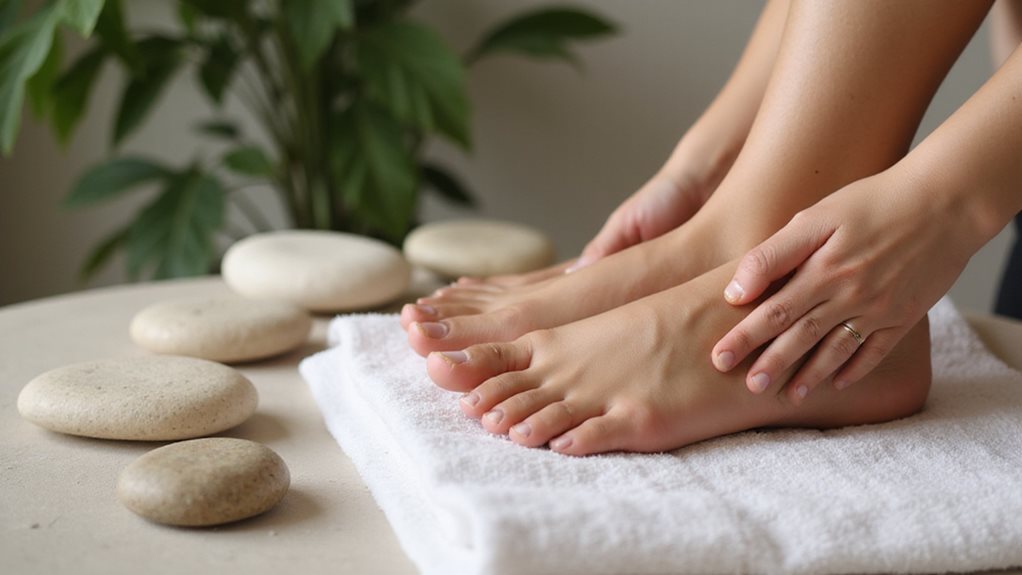Reflexology, a therapeutic practice rooted in ancient wisdom, offers a distinctive path to wellness by stimulating specific points on the feet, hands, and ears. These points correspond to essential organs and systems, promoting balance and healing throughout the body. With its gentle yet precise approach, it addresses both physical and psychological needs. How does this time-honored technique reveal such profound benefits? The quest to understand its impact awaits exploration.
Key Takeaways
- Reflexology boosts wellness by improving circulation, aiding toxin removal, and enhancing overall body balance.
- It reduces stress and anxiety through endorphin release, promoting emotional stability.
- Targeting specific reflex zones relieves pain, supporting holistic pain management.
- Reflexology enhances immune defense by stimulating T-cell production and reducing inflammation.
- It supports detoxification by increasing lymphatic drainage and clearing energy pathways.
Understanding the Basics of Reflexology
Reflexology, a holistic therapy, focuses on applying targeted pressure to specific points on the feet, hands, and ears to promote general wellness. With roots in ancient civilizations and modern adaptations from the early 20th century, it operates on the belief that reflex points correspond to diverse organs and systems in the body. By using thumb and finger manipulations without oils, practitioners aim to restore balance and harmony non-invasively.
Understanding how reflexology improves wellness involves recognizing its core principles, like zone theory, which maps the body into longitudinal zones. Pressure on reflex areas sends biochemical signals, fostering a sense of connection and vitality. This therapy is often used as a complementary approach to medical treatments, enhancing overall health without diagnosing or treating specific illnesses. For those seeking holistic care, reflexology offers a welcoming path to inner harmony and general well-being.
Alleviating Chronic Pain Naturally
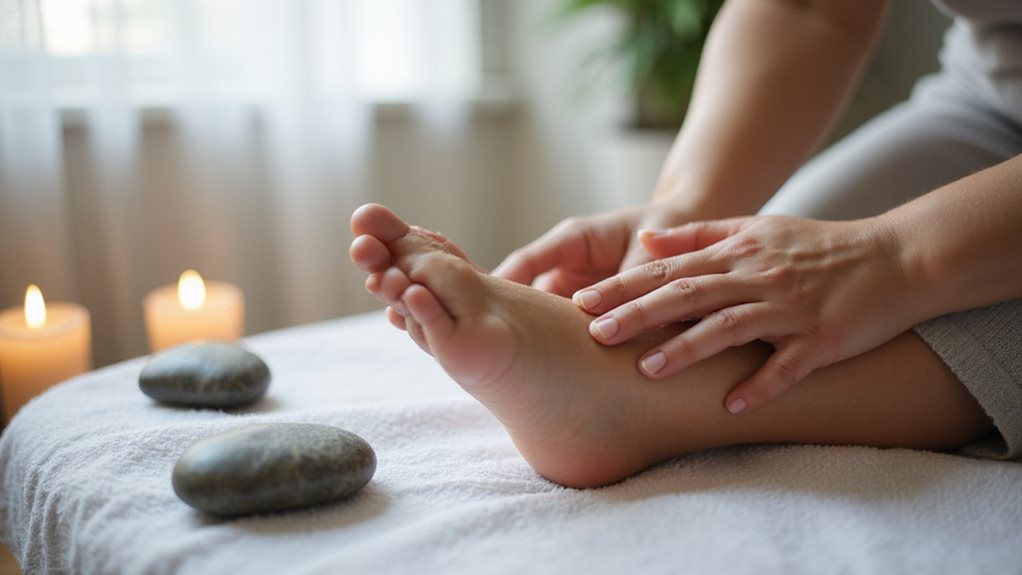
Reflexology offers a promising avenue for alleviating chronic pain by targeting specific reflex pain zones on the feet and hands, which correspond to different body parts. This practice incorporates a holistic pain management approach, addressing not just symptoms but the interconnected nature of physical discomfort and general well-being. For those enduring persistent pain, such targeted and thorough care can provide meaningful relief without relying solely on medication. Research from twenty-seven studies has demonstrated that reflexology can significantly reduce pain in conditions like AIDS, chest pain, and osteoarthritis reduce pain significantly.
Targeting Reflex Pain Zones
A remarkable approach to pain management, reflexology targets specific zones on the feet that correspond to different body regions, offering a natural pathway to alleviate chronic discomfort. By applying pressure to these mapped areas, such as the big toe for head and neck issues or outer zones for side-body pain, people can experience systemic relief. Studies reveal a 31% reduction in chronic back pain and significant post-surgical relief, as seen in kidney transplant and cesarean patients.
This practice also triggers relaxation responses, easing tension that fuels persistent pain. For those seeking a supportive community in wellness, reflexology offers a shared path toward comfort, effectively addressing headaches, musculoskeletal issues, and neuropathic conditions through precise, zone-based techniques. Additionally, research highlights reflexology’s potential to lower pain scores by notable percentages, with a 43% reduction in chronic pain reported among males in a 2018 survey.
Holistic Pain Management Approach
How can people find relief from chronic pain without relying on medications? Reflexology offers a holistic pain management approach that many are embracing as a natural alternative. By applying manual pressure to specific points on the feet, hands, or ears, this non-pharmacological method helps alleviate discomfort without the risks associated with drugs. It stands as a safe complementary therapy, easily integrated into conventional care plans by healthcare providers.
For those seeking a sense of community in their healing path, reflexology resonates widely—over two-thirds of Americans with chronic pain turn to such therapies. Its minimal risks and clinical applicability make it a welcoming option for anyone yearning to manage pain naturally, fostering a shared path to wellness and relief. Research supports its effectiveness, with studies showing a significant average pain reduction in chronic pain cases through reflexology.
Targeting Lower Back Discomfort
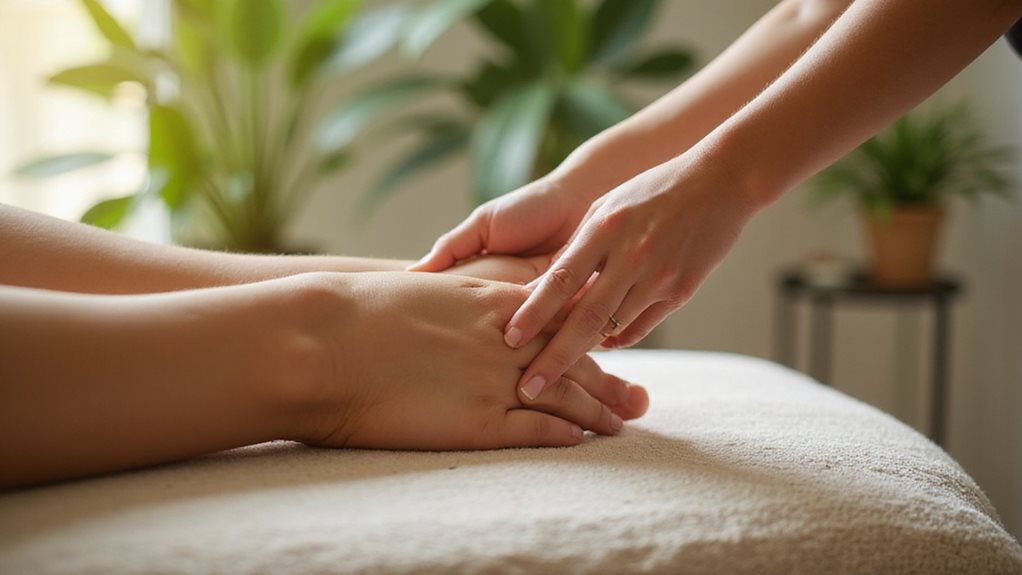
Reflexology offers a targeted approach to easing lower back discomfort by focusing on the heel reflex zone, which corresponds to the spine and surrounding muscles. This method applies precise pressure to naturally relieve pain, helping to release tension and promote healing in affected areas. By balancing the body through these pressure points, people often experience a renewed sense of physical harmony and reduced strain. Additionally, this technique improves circulation to nerves in the back, enhancing overall spine health and well-being.
Heel Reflex Zone Focus
The intricate connection between the heel and lower back reveals a profound pathway for addressing discomfort through reflexology. Nerves like the S1 root link these areas, often causing pain to radiate from spine to heel. By focusing on specific heel reflex zones, such as the inner lateral edge corresponding to lumbar vertebrae, practitioners can target tension in the L1-L5 region.
Applying precise pressure to the inner sole between heel and mid-foot helps release stress tied to spinal irritation. Spending extra time on these zones during sessions can ease persistent discomfort. This approach is particularly effective because the sciatic nerve, originating in the lower back, can contribute to foot pain when compressed sciatic nerve compression. For those seeking relief, this gentle, non-invasive approach fosters a sense of connection and care, harmonizing body and mind through shared healing practices within a supportive community.
Easing Back Pain Naturally
Why do so many people endure persistent lower back discomfort when natural solutions exist? Reflexology offers a gentle, effective approach, targeting spinal issues through specific pressure points. By focusing on the junction of the thumb and index finger, you can address discomfort in the lower back with ease thumb-index junction.
Balancing Body Through Pressure
While chronic lower back discomfort plagues countless people, a targeted approach through reflexology offers a promising avenue for relief. By applying pressure to specific foot zones linked to the back, reflexology stimulates nerve pathways, easing pain perception and relaxing tense muscles. This method also enhances circulation, delivering oxygen and nutrients to spinal tissues while reducing swelling.
Beyond physical relief, reflexology activates the relaxation response, lowering cortisol levels and releasing endorphins—natural painkillers that soothe discomfort. Regular sessions, ideally three times weekly for 30 minutes, have shown significant pain reduction in diverse groups, from nurses to the general public. Studies, such as those conducted in 2015 and 2022, confirm that reflexology can effectively reduce back pain after consistent sessions. For those seeking holistic balance, integrating reflexology with yoga or meditation can deepen wellness, fostering a shared path toward lasting comfort.
Reducing Stress and Anxiety
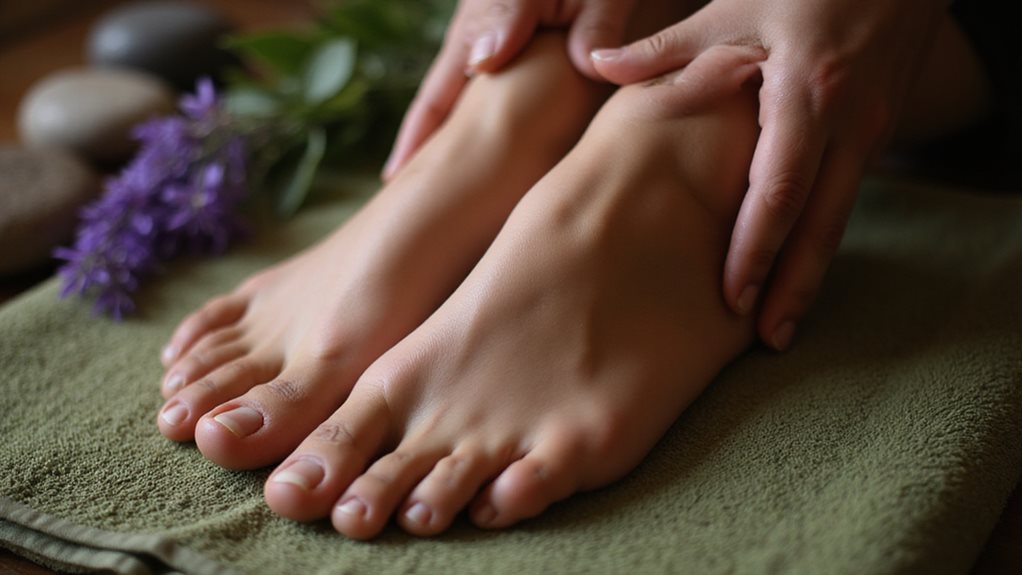
As stress and anxiety increasingly burden modern life, reflexology emerges as a promising avenue for relief. This gentle therapy activates the parasympathetic response, easing the body into a “rest and digest” state, while reducing muscle tension and regulating stress hormones like cortisol. It fosters calm by triggering endorphin release and calming mental strain, offering a sanctuary for those seeking peace. A 2017 study demonstrated that hand reflexology significantly reduced anxiety levels before coronary angiography, highlighting its potential as a supportive therapy.
Below is a snapshot of reflexology’s impact on stress:
| Aspect | Benefit |
|---|---|
| Physiological | Reduces tension, improves circulation |
| Hormonal | Lowers cortisol via relaxation |
| Psychological | Calms anxiety, improves mood |
| Sleep Quality | Eases stress-related insomnia |
| Targeted Relief | Addresses specific stress zones |
For a community seeking comfort, reflexology provides a nurturing, nonpharmacological path to unwind and reconnect.
Promoting Emotional Balance

Reflexology offers a profound approach to reducing mental stress by triggering the release of endorphins, which help counteract negative feelings and foster a sense of calm. It also improves mood stability through the stimulation of serotonin and dopamine, supporting the body’s natural ability to maintain mental equilibrium. This therapeutic practice provides a supportive pathway for people seeking relief from mental burdens and a steadier psychological state. Furthermore, by enhancing blood flow, reflexology oxygenates the brain and helps disrupt system stagnation, promoting overall emotional wellness.
Reducing Emotional Stress
How can one find relief from the relentless weight of psychological stress in today’s fast-paced world? Reflexology offers a nurturing path to mental ease, gently activating the parasympathetic nervous system to calm the body’s “fight or flight” response. By stimulating specific reflex points, it reduces stress hormones like cortisol, fostering deep relaxation and systemic balance. This practice also releases muscle tension tied to mental strain, easing somatic symptoms and lowering heart rate. Moreover, reflexology supports neurotransmitter regulation, balancing stress-disrupted pathways for mental resilience. Improved circulation nourishes organs impacted by stress, while clinical studies affirm its role in anxiety reduction. For those seeking comfort, reflexology provides a supportive, holistic acceptance, welcoming all into a community of calm and restoration. Additionally, this therapy promotes emotional well-being by enhancing the release of endorphins, which can significantly uplift mood and counteract depressive feelings.
Enhancing Mood Stability
People seeking mental equilibrium often find comfort in reflexology’s profound ability to improve mood stability. This holistic practice stimulates the release of serotonin and dopamine, vital neurotransmitters that regulate mood and foster mental resilience. By activating the parasympathetic nervous system, reflexology lowers cortisol levels, reduces heart rate, and promotes deep relaxation, countering stress and hyperarousal.
Additionally, it targets reflex points linked to anxiety-sensitive areas, alleviating tension and supporting hormonal balance. Improved blood circulation and vagal tone further nurture a calm state, while increased alpha/theta brain wave activity signifies focused tranquility. For those yearning to belong to a community of wellness, reflexology offers a supportive path to mental balance, helping people navigate life’s challenges with renewed stability and inner peace. Consistent reflexology sessions can also provide cumulative benefits, enhancing overall stress management over time with regular practice.
Boosting Relaxation During Health Challenges
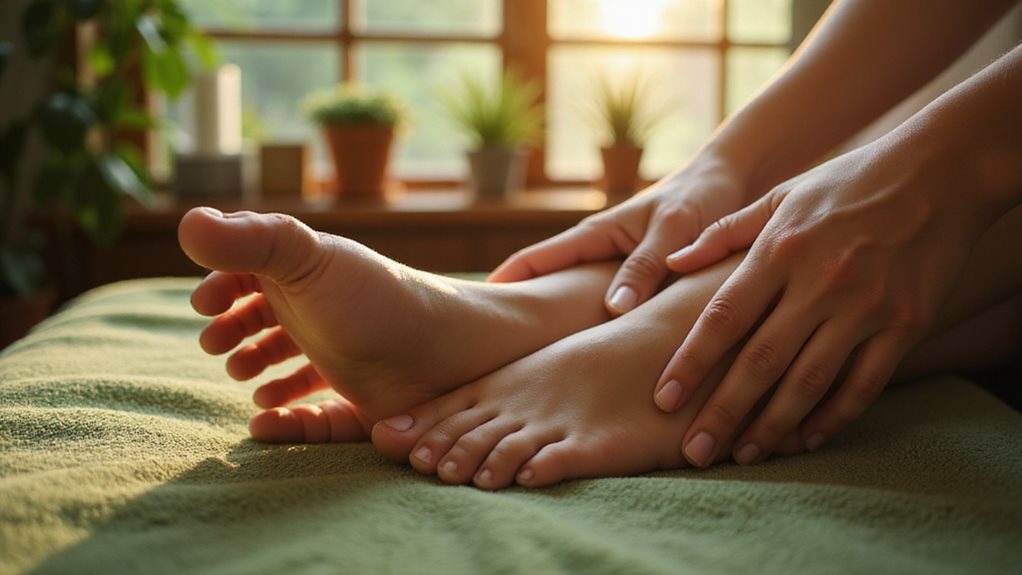
Why might people facing health challenges turn to alternative therapies for relief? For many, the burden of chronic illness or acute conditions brings stress and anxiety, prompting a search for gentle, supportive care. Reflexology offers a nurturing path, promoting relaxation through targeted pressure points on the feet. Studies show it reduces heart rate and anxiety in heart surgery patients and cancer survivors, while easing physical pain tied to stress in arthritis and MS. Additionally, reflexology is often valued for its ability to foster a therapeutic connection between practitioner and patient, enhancing emotional well-being.
| Health Challenge | Reflexology Benefit |
|---|---|
| Cancer | Reduces anxiety and discomfort |
| Heart Surgery | Lowers heart rate and stress |
| Arthritis | Eases pain through relaxation |
| Multiple Sclerosis | Relieves fatigue and sensory tension |
| PMS | Improves mood and symptom relief |
This shared path fosters calm and connection.
Enhancing Immune Defense Mechanisms
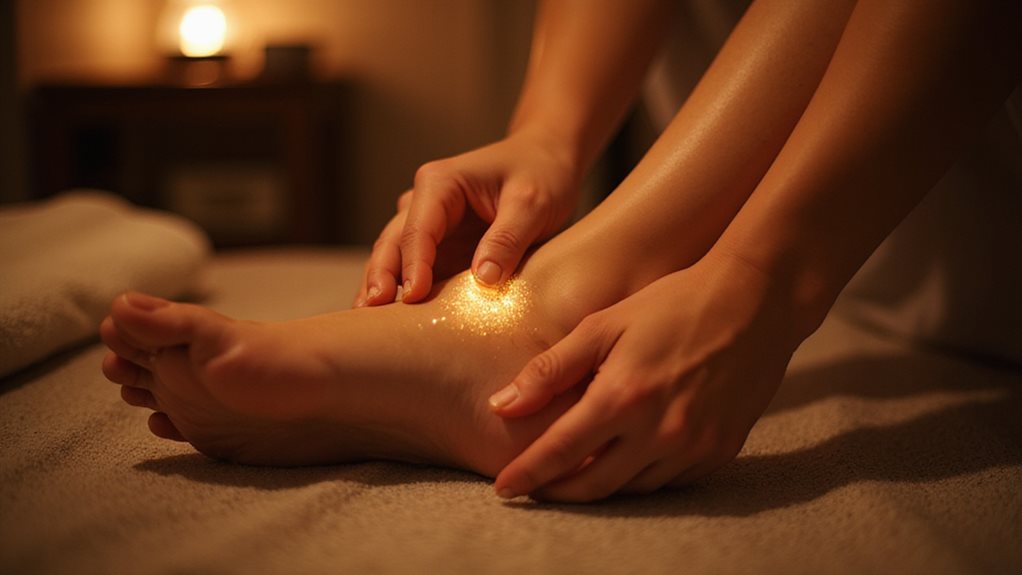
Could reflexology serve as a crucial ally in strengthening the body’s natural defenses? Many believe it can, as this practice targets specific reflex points like the thymus under the big toe joints to increase T-cell production, crucial for fighting pathogens. Spleen and lymphatic reflexes on the foot arches improve blood filtration and immune cell circulation, fortifying systemic resilience.
Beyond physical points, reflexology reduces cortisol through parasympathetic activation, easing stress that often weakens immunity. It also triggers endorphin release, curbing inflammation while supporting general balance. By stimulating foot nerves, it fosters communication between immune organs and the nervous system. Additionally, reflexology can enhance the lymphatic network’s role in distributing lymph fluid to cleanse and remove waste products. For those seeking holistic wellness, reflexology offers a nurturing path to bolster the body’s defenses, fostering a sense of shared healing.
Supporting Detoxification Processes
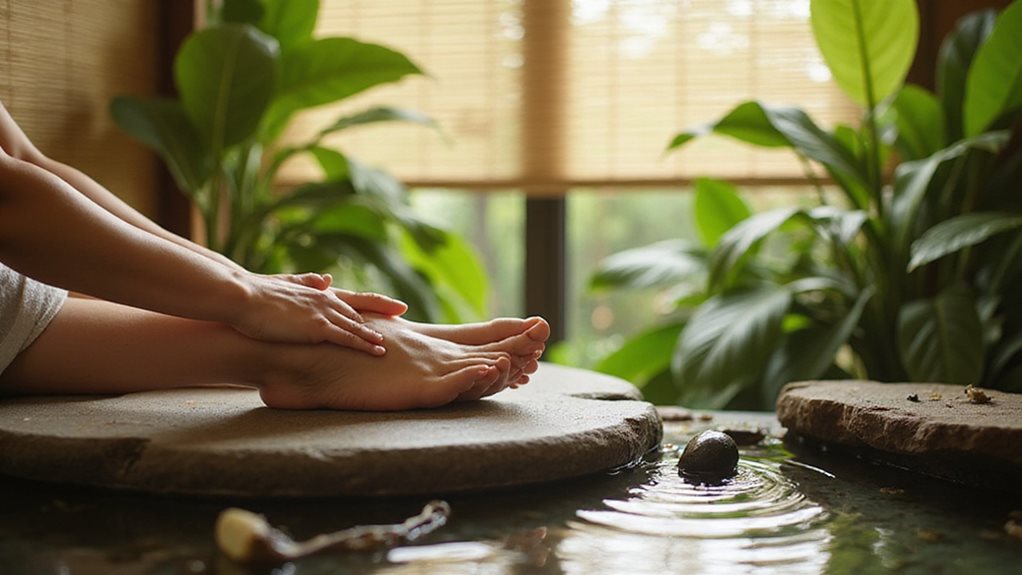
Reflexology plays a significant role in supporting detoxification processes by increasing lymphatic drainage, which helps filter out harmful substances from the body. It also improves toxin removal through improved circulation and stimulation of reflex points linked to essential organs like the kidneys and liver. By fostering these mechanisms, reflexology supports the body’s natural cleansing abilities, promoting a renewed sense of balance and well-being. Additionally, it enhances energy flow by clearing obstructed pathways, aiding in the elimination of toxin buildup.
Boosting Lymphatic Drainage
Enhancing the body’s natural detoxification processes, reflexology offers a powerful approach to enhancing lymphatic drainage. By targeting specific pressure points, it supports the lymphatic system’s essential role in maintaining wellness, fostering a sense of balance and renewal for those seeking holistic care.
Key benefits of reflexology in this area include:
- Stimulating Lymph Flow: It mimics manual lymphatic drainage techniques, encouraging the natural movement of lymph fluid.
- Reducing Congestion: It helps alleviate blockages, easing conditions like lymphedema with gentle precision.
- Supporting Immune Health: By activating lymphatic pathways, it bolsters the body’s defenses, enhancing general vitality.
Through these mechanisms, reflexology nurtures the body’s cleansing processes, inviting people into a community of mindful, supportive health practices.
Enhancing Toxin Removal
How can one support the body’s natural ability to cleanse itself of harmful substances? Reflexology offers a gentle yet effective approach by targeting specific reflex zones linked to essential organs like the liver, kidneys, and colon. This practice improves metabolic waste processing and accelerates toxin elimination when applied with care. By stimulating meridians, it restores energy balance, aiding the dispersal of toxins while reducing stress hormones through parasympathetic activation. People may experience mild, transient detox symptoms as the body releases stored impurities. Regular sessions foster a sustained pattern of toxin removal, inviting a sense of renewal. For those seeking to belong to a wellness-focused community, reflexology provides a nurturing path to support the body’s innate detoxification processes with precision and empathy.
Supporting Body Cleansing
People seeking to bolster their body’s natural purification systems can find a powerful ally in reflexology. This holistic practice supports detoxification by stimulating specific reflex points on the feet, enhancing the body’s ability to cleanse itself. It nurtures essential systems like the lymphatic and circulatory networks, ensuring efficient waste removal and hormonal balance.
Key ways reflexology aids cleansing include:
- Lymphatic Drainage – Enhances filtration of contaminants and reduces inflammation.
- Gut Health – Stimulates digestive organs for effective toxin breakdown and nutrient absorption.
- Energy Flow – Clears stagnant “qi” through meridian stimulation for cellular detox.
Managing Autoimmune Conditions
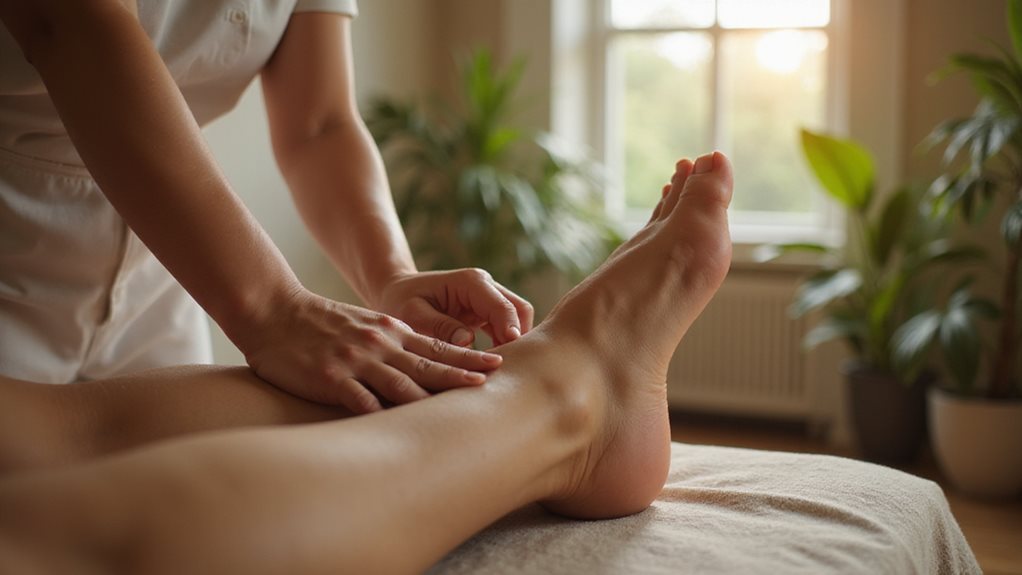
Could reflexology offer a supportive path for those grappling with autoimmune conditions? For people managing the challenges of diseases like rheumatoid arthritis or multiple sclerosis, reflexology presents a gentle, holistic approach. It reduces stress by lowering cortisol levels and promoting relaxation, which can minimize symptom flares triggered by anxiety.
Beyond psychological well-being, reflexology alleviates pain and inflammation through improved circulation, easing joint swelling and discomfort. It also supports immune balance by improving lymphatic flow and reducing stress-related inflammation, helping to stabilize autoimmune activity. By integrating reflexology into their wellness routine, people may find a complementary tool to improve pain relief and general quality of life, fostering a sense of control and connection in their healing path.
Improving Nerve Health and Function
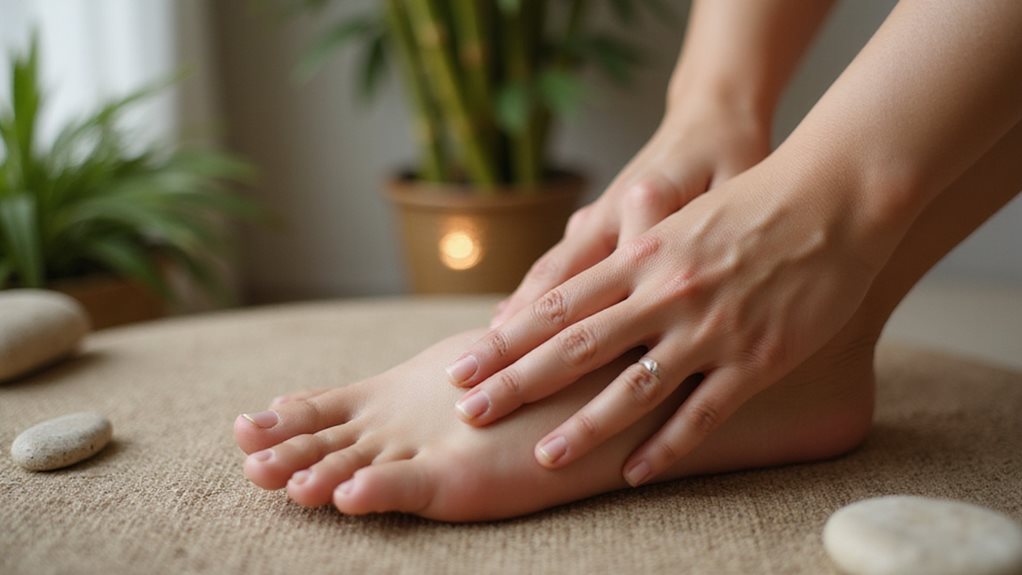
Reflexology offers a promising avenue for enhancing nerve health and function, particularly for people facing chronic neurological challenges. This gentle, non-invasive practice targets specific reflex points to stimulate nerve endings, fostering improved communication within the body’s intricate nervous system. It welcomes people into a supportive space where holistic care can restore balance and vitality.
Key benefits include:
- Reactivating Pathways: Pressure on reflex points revives dormant nerves, enhancing sensory and motor responses.
- Boosting CNS Connection: It optimizes data transmission between peripheral nerves and the central nervous system for systemic harmony.
- Supporting Pain Relief: Targeted stimulation eases chronic pain by resetting nerve tension and improving coordination.
Through reflexology, one can find a nurturing path to renewed nerve wellness and general comfort.
Addressing Neuropathy Concerns
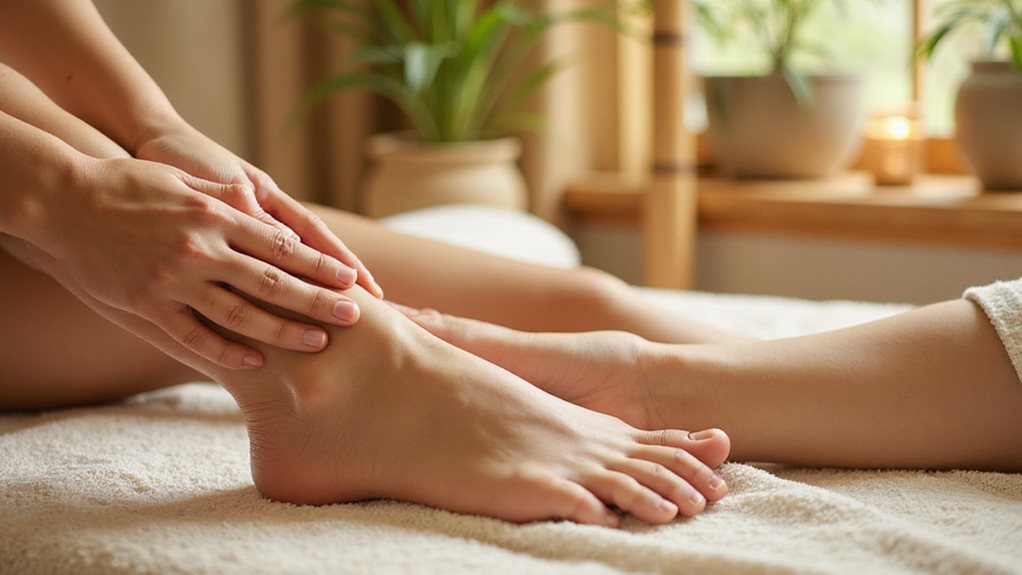
People experiencing neuropathy often grapple with persistent discomfort and disrupted daily routines, a concern that builds on the foundation of nerve health discussed earlier. Reflexology offers a compassionate, non-invasive approach to ease this burden, showing a 52.4% greater reduction in neuropathic pain intensity for diabetic patients compared to control groups. By applying targeted pressures to reflex points, it desensitizes hypersensitive nerves, mitigating sharp or burning sensations while reducing symptom interference in daily tasks.
Moreover, reflexology supports psychological well-being within a supportive community framework. It activates endorphins for natural pain relief and mood improvement, while promoting relaxation through parasympathetic pathways. Regular sessions also improve sleep quality, counteracting nighttime discomfort, and enable people to reclaim control over their wellness path together.
Optimizing Blood Flow and Healing
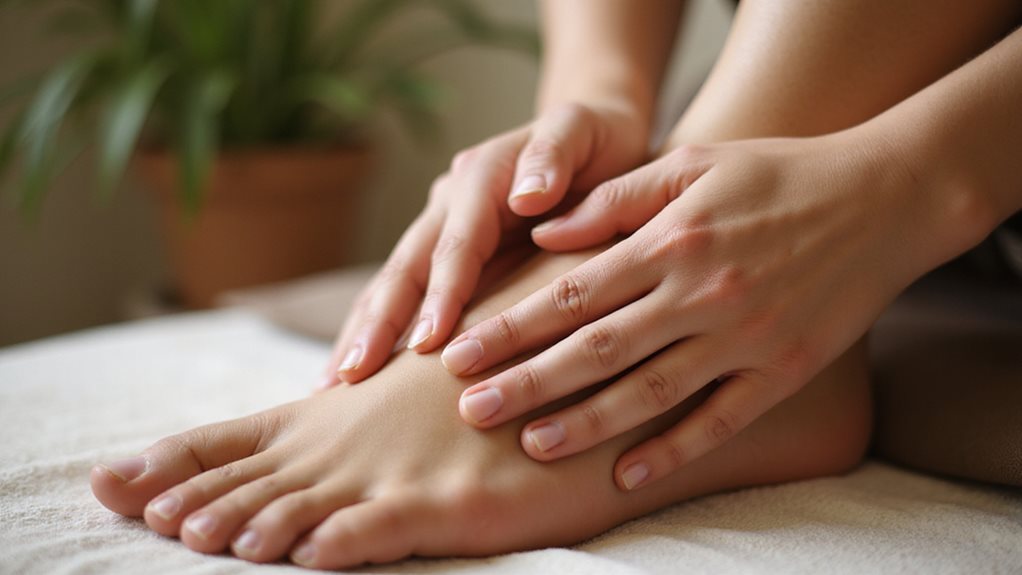
While neuropathy presents significant challenges, optimizing blood flow through reflexology offers a promising avenue for holistic healing. This practice nurtures the body by improving circulation, delivering oxygen-rich blood to tissues, and supporting cellular repair. It fosters a sense of renewal for those seeking natural wellness solutions within a supportive community.
Reflexology’s benefits are evident in:
- Improved Circulation: Targeted foot pressure increases blood flow to essential organs, aiding nutrient distribution and temperature regulation.
- Stress Reduction: Reflex zones release endorphins, reducing inflammation and easing physical tension.
- Accelerated Healing: Improved metabolic efficiency and toxin removal support faster recovery from injuries.
Through regular sessions, people can experience reduced swelling, improved cell regeneration, and a profound connection to holistic well-being.
Supporting Cardiovascular Wellness
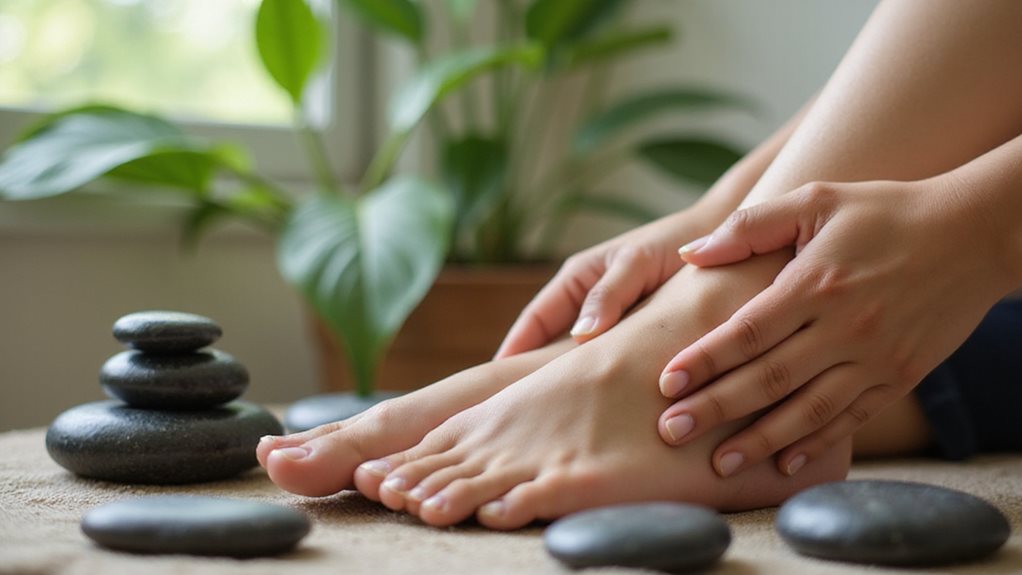
People seeking holistic approaches to health often find reflexology a valuable tool for supporting cardiovascular wellness. This practice targets specific foot reflex points linked to the heart, helping regulate cardiac function, lower blood pressure, and improve circulation. Clinical evidence shows it reduces systolic and diastolic readings in hypertensive patients while enhancing oxygen delivery to heart tissues.
Additionally, reflexology activates the parasympathetic nervous system, easing stress and anxiety that strain the heart. Combined with calming aromatic oils like lavender or ylang ylang, it fosters relaxation and counters cortisol’s harmful effects. For those in the holistic health community, regular sessions offer a non-invasive complement to traditional care, promoting long-term heart resilience and a shared path toward balanced, vibrant wellness.
Encouraging Better Sleep Patterns
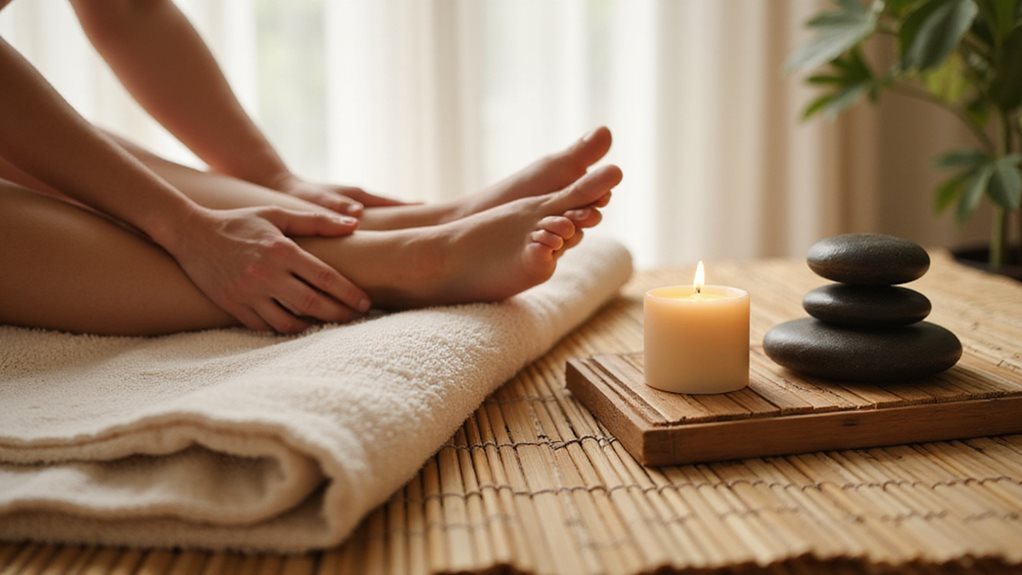
How can one achieve restful nights amidst the challenges of modern stress? Reflexology offers a gentle, non-invasive path to better sleep by targeting specific reflex points linked to relaxation and hormonal balance. Studies show it notably lowers Pittsburgh Sleep Quality Index scores, reducing delays in falling asleep and extending sleep duration, particularly for older adults.
Struggling with sleep amid modern stress? Reflexology gently targets reflex points, promoting relaxation and better rest, as supported by sleep quality studies.
Key benefits include:
- Nervous System Calming: Modulates stress responses, easing sleep disruptions.
- Hormonal Regulation: Supports melatonin and serotonin balance for circadian rhythm stability.
- Reduced Sedative Reliance: Promotes natural sleep, enhancing long-term wellness.
This accessible practice, often paired with evening foot baths, invites a sense of calm and belonging, helping people reclaim restful nights through customized, caring touch.
Frequently Asked Questions
Is Reflexology Safe During Pregnancy?
Reflexology is generally safe during pregnancy for managing labor pain and anxiety, provided it’s performed by trained professionals. Caution is advised for high-risk cases, ensuring tailored care for each person’s specific needs.
Can Reflexology Help With Digestive Issues?
Hark, in this modern age, digestive woes plague many! Reflexology, with its targeted pressure points, aids in easing bloating and constipation. Join a community finding relief through this empathetic, precise healing art.
How Often Should I Get Reflexology Sessions?
Determining reflexology session frequency depends on specific needs. For acute issues, weekly sessions are advised initially, while chronic conditions may need sustained frequency. Maintenance often involves monthly visits, adjusted based on specific responses.
Does Reflexology Treat Skin Conditions?
Research suggests 70% of chronic skin condition sufferers report stress as a trigger. Reflexology may help by targeting stress-related reflexes, potentially easing eczema or psoriasis. Join a community exploring this supportive, holistic approach.
Is Reflexology Suitable for Children?
Reflexology is indeed suitable for children, offering gentle, non-invasive support. It can ease pain, improve mood regulation, and aid development. With trained practitioners, it provides a safe, nurturing option for young ones’ well-being.
Conclusion
Finally, reflexology emerges as a life-changing path to exceptional wellness, guiding people toward a healthier, more balanced life. By utilizing the body’s innate healing power through precise pressure points, it alleviates pain, reduces stress, and nurtures psychological harmony. Its profound impact on circulation, sleep, and general vitality offers a holistic integration of well-being. For anyone seeking natural rejuvenation, reflexology stands as a trusted ally in the path to ideal health.
